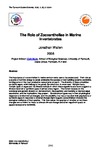Diversity, abundance, and distribution of ground invertebrates in Lower Sharpham Farm
| dc.contributor.author | Zavala Quiroga, V. | |
| dc.date.accessioned | 2023-12-22T15:24:29Z | |
| dc.date.available | 2023-12-22T15:24:29Z | |
| dc.date.issued | 2023 | |
| dc.identifier.citation |
Zavala Quiroga, V. (2023) 'Diversity, abundance, and distribution of ground invertebrates in Lower Sharpham Farm', The Plymouth Student Scientist, 16(2), pp. 314-346. | en_US |
| dc.identifier.uri | https://pearl.plymouth.ac.uk/handle/10026.1/21835 | |
| dc.description.abstract |
Invertebrates constitute the largest group of animals on Earth and represent the bulk of biodiversity. They are responsible for numerous essential ecosystems services and are at the centre of many terrestrial food webs. Due to habitat loss from land use change and conversion to intensive agriculture, they are experiencing a substantial decline in biodiversity, hence conservation approaches such as rewilding have been sought. There are limited studies of invertebrate biodiversity in rewilding projects, therefore the aim of this study is to investigate the diversity and abundance of ground invertebrates at Lower Sharpham Farm and the influences of vegetation structure in a rewilded field and a farmed field. 18 pitfall traps were installed in each field divided into 3 groups of 6 and were left outside for 5 days. After collection, 856 invertebrates were found and identified in the laboratory. During that period, a vegetation survey was also carried out. Results within rewilded field indicate that group 1 showed to have a higher invertebrate abundance (n=205) and species richness (n=15) with higher biodiversity index (H=1.88). Results within farmed field indicate that the area in group 1 showed to have a higher invertebrate abundance (n=124) while group 3 had a higher species richness (n=13) with a higher biodiversity index result (H=2.12). Results between fields comparison indicate that rewilded fields increase invertebrate abundance (n=559), though grazing in farmed fields has little effect on invertebrate richness but decreases abundance (n=297). Farmed field had a slightly higher biodiversity index result (H=1.87) compared to rewilded field (H=1.82) due to the high dominance of springtails (Entomobryomorpha). This study determines that rewilding works as a tool for promoting invertebrate abundance and that organic farms have a positive impact on invertebrate diversity. Overall, long-term regular monitoring is needed to evaluate the success of rewilding for biodiversity overtime. The outcomes of the study not only evidence the importance of rewilding for invertebrate conservation but also the importance of low intensive agriculture practices for biodiversity. | en_US |
| dc.language.iso | en | en_US |
| dc.publisher | University of Plymouth | en_US |
| dc.rights | Attribution 3.0 United States | * |
| dc.rights.uri | http://creativecommons.org/licenses/by/3.0/us/ | * |
| dc.subject | Ground invertebrates, | en_US |
| dc.subject | rewilding | en_US |
| dc.subject | organic farm | en_US |
| dc.subject | invertebrate biodiversity | en_US |
| dc.subject | invertebrate conservation | en_US |
| dc.subject | low intensive agriculture | en_US |
| dc.subject | invertebrate monitoring | en_US |
| dc.subject | grazing | en_US |
| dc.subject | ecological restoration | en_US |
| dc.title | Diversity, abundance, and distribution of ground invertebrates in Lower Sharpham Farm | en_US |
| dc.type | Article | en_US |
| plymouth.issue | 2 | |
| plymouth.volume | 16 | |
| plymouth.journal | The Plymouth Student Scientist |





